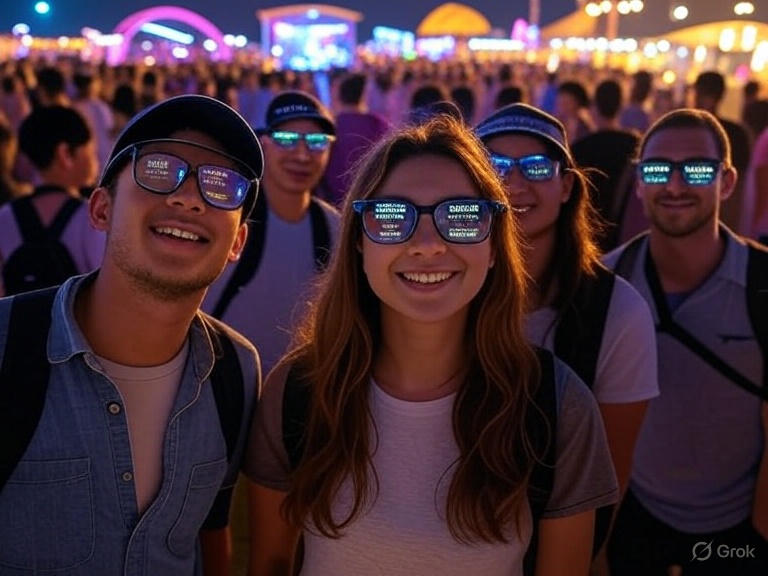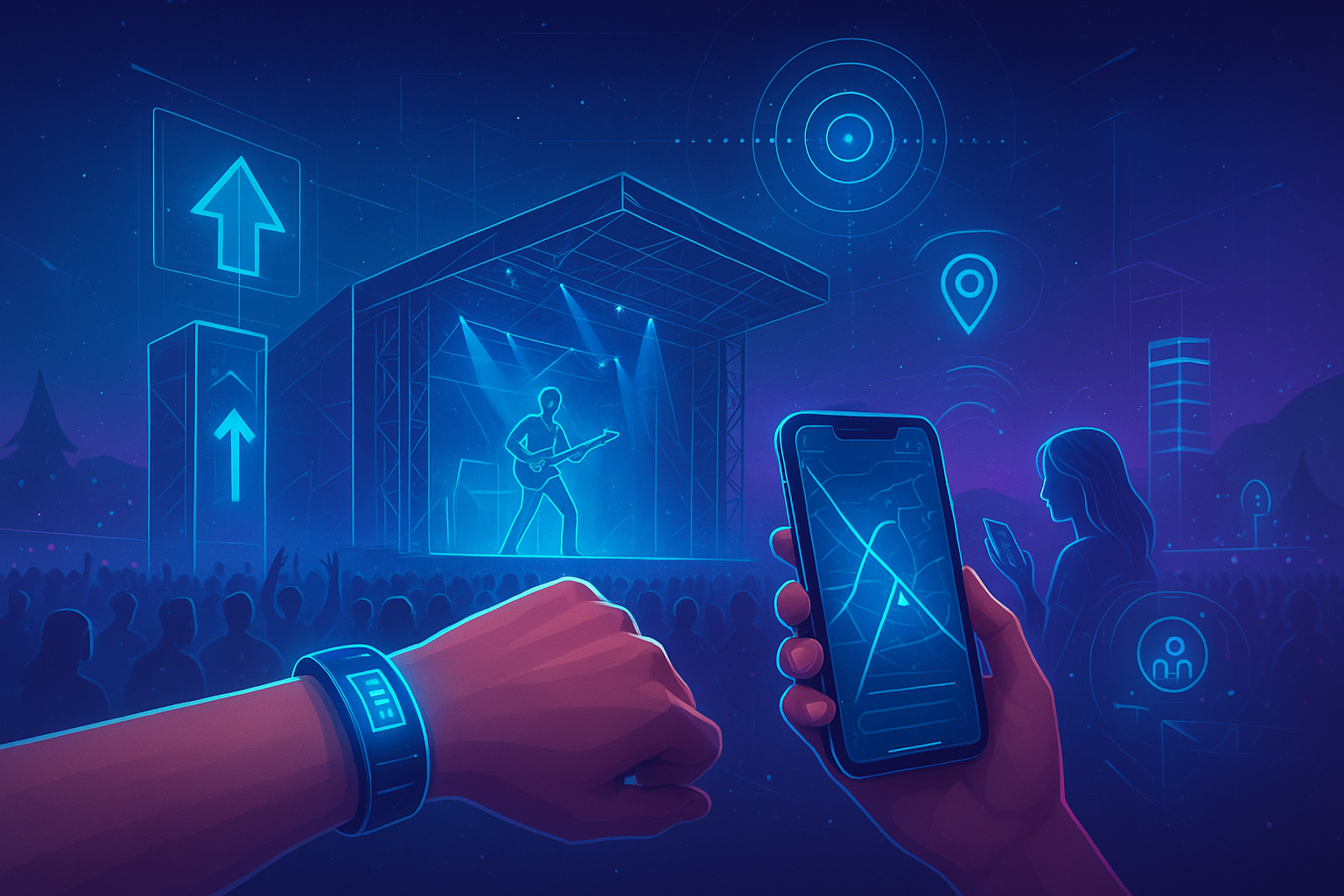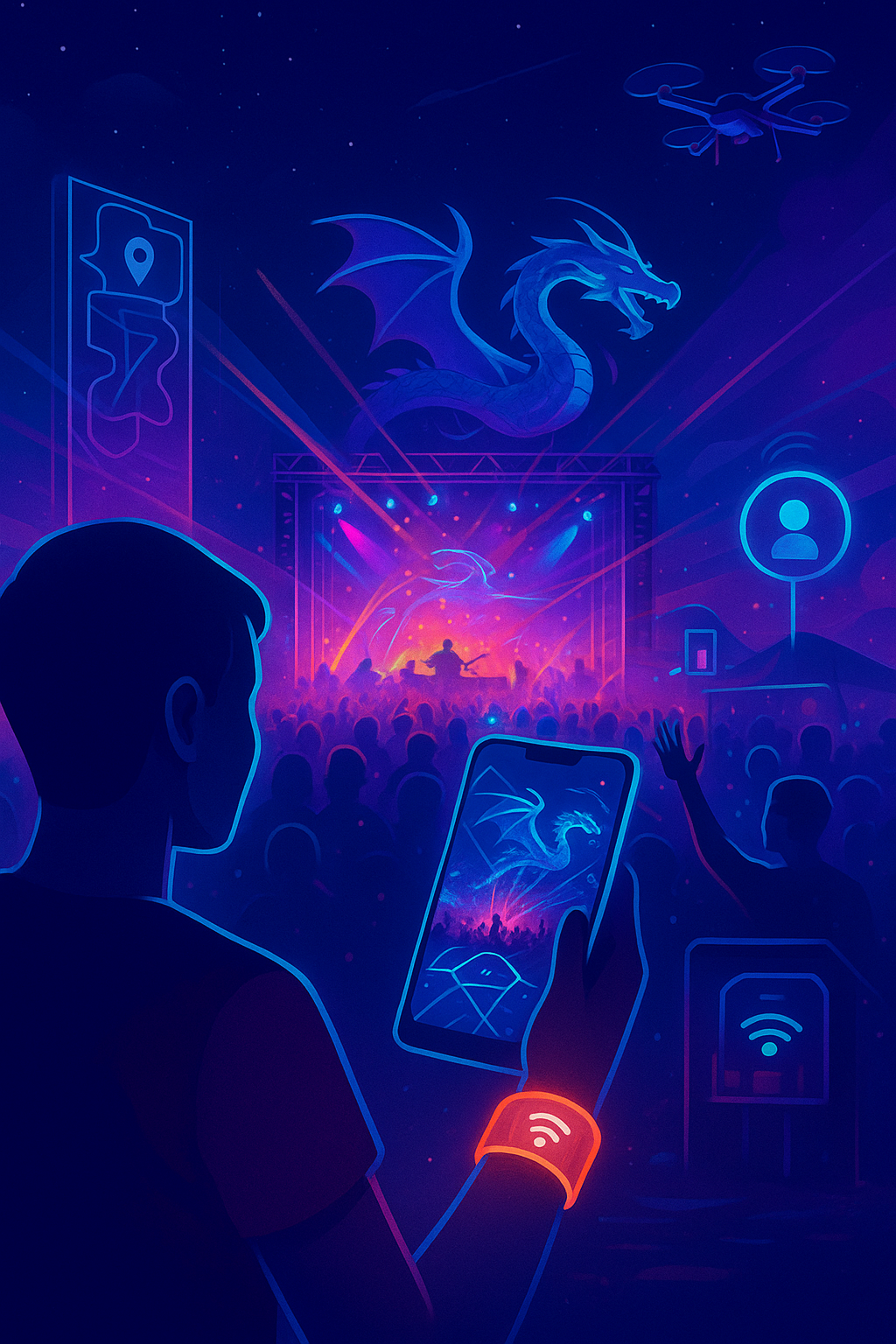Imagine arriving at a massive festival and instantly seeing a personalized path illuminated before you, guiding you effortlessly to your friends while highlighting points of interest along the way. Building on the intuitive navigation that FindTribe already provides, this next evolution in technology could further enhance how we experience events. This isn't science fiction—it's the approaching future of augmented reality (AR) technology, and it represents the next frontier in event navigation and social experiences.
The AR Revolution: Beyond Smartphone Screens
For years, augmented reality has been confined primarily to our smartphone screens—think Pokémon GO or simple face filters. But we're now witnessing a pivotal shift as AR moves toward wearable devices that could blend more seamlessly into our everyday lives. The latest generation of AR-capable eyewear from companies like Meta represents early steps in this direction, with more advanced systems in development.
Unlike their bulky predecessors, today's AR glasses look increasingly like normal eyewear. Meta's collaboration with Ray-Ban has produced glasses that are virtually indistinguishable from traditional sunglasses while packing sophisticated technology. Meanwhile, various tech companies including Apple are exploring AR technologies that could eventually bring their design sensibility and ecosystem integration to future wearable experiences.
"The latest Meta Ray-Ban glasses have already sold over two million units since their October 2023 launch, signaling growing interest in smart eyewear that could eventually support full AR experiences."
What makes these emerging technologies potentially revolutionary is their ability to layer digital information directly onto our view of the physical world without requiring us to look down at a screen. This hands-free, heads-up experience represents a fundamental shift in how we might interact with digital information—one that could be particularly valuable in dynamic, crowded environments like festivals, conferences, and sporting events.
The Cognitive Science of Navigation
To understand why AR navigation represents such a potential breakthrough for events, we need to examine how humans naturally navigate spaces. Traditional static paper maps force users to constantly switch contexts—looking down at a map, then up at surroundings, then back down again. This creates what cognitive scientists call a high "cognitive load," requiring our brains to constantly translate between 2D representations and 3D reality.
Research from the Stanford Virtual Human Interaction Lab shows that this context-switching can increase cognitive load significantly, leading to slower navigation, increased stress, and more frequent errors. FindTribe's current approach already addresses this by providing dynamic, GPS-based navigation similar to what users are familiar with from city navigation apps—a major improvement over static maps. AR could potentially take this even further by overlaying directional cues directly onto our view of the real world.
The Cognitive Advantage
Early research into AR navigation suggests it could significantly reduce the mental effort required for wayfinding compared to traditional paper maps. FindTribe's current dynamic navigation system already offers many of these cognitive benefits by providing real-time, personalized guidance that updates as you move.
These cognitive advantages become even more pronounced in complex, unfamiliar environments like festival grounds or convention centers—precisely the types of spaces where FindTribe's intuitive navigation system currently shines, and where future AR integration could offer additional enhancements.
AI-Powered Contextual Awareness
The latest AR systems aren't just displaying static information—they're becoming increasingly intelligent thanks to integration with sophisticated AI systems. These AI assistants can understand context, anticipate needs, and provide information that's relevant to your specific situation and preferences.
For example, Meta's AI assistant can now recognize what you're looking at and provide relevant information about it. Point your glasses at a stage schedule, and the AI might offer to set reminders for performances you've expressed interest in. Look at a food vendor, and it could tell you the wait time or popular menu items based on real-time data.
"The integration of multimodal AI with AR glasses creates a system that doesn't just see what you see—it understands what you're looking at and why it might matter to you in that specific moment."
This contextual awareness represents a fundamental shift in how technology assists us. Rather than requiring explicit commands or searches, these systems can proactively offer relevant information based on environmental cues and personal preferences—a capability that's particularly valuable in information-rich environments like events.
Beyond Navigation: The Social Dimension
While improved navigation is a compelling use case, AR's potential at events extends far beyond simply getting from point A to point B. Perhaps the most exciting applications involve enhancing social connections—the very heart of what makes live events special.
Finding friends in crowded venues has always been a challenge, often involving complex coordination via text messages with vague landmarks as reference points. FindTribe already solves this problem effectively with our real-time friend location features. Future AR glasses with friend-finding capabilities could potentially build on this foundation by displaying the real-time location of your group members directly in your field of view—even in crowds where traditional GPS lacks the necessary precision.
Enhanced Social Coordination
FindTribe's current friend-finding features already dramatically reduce the time needed to locate group members. Future AR integration could potentially make this process even more seamless by bringing this functionality directly into your field of view.
Beyond simply locating friends, these systems could facilitate more meaningful social interactions. Imagine your glasses highlighting people with shared interests at a networking event, or showing which of your friends have already visited a particular art installation at a festival. These capabilities could transform events from potentially overwhelming experiences into richly connected social environments.
Real-Time Crowd Intelligence
One of the most promising applications of AR at events involves using collective data to optimize individual experiences. By aggregating anonymized movement data from multiple users, these systems can develop real-time understanding of crowd dynamics throughout a venue.
This crowd intelligence can then be used to route individuals more efficiently, directing them away from congested areas and toward less crowded pathways. Research from MIT's Senseable City Lab suggests that such systems could significantly improve movement through crowded venues while simultaneously decreasing dangerous crowd density in high-traffic areas.
Dynamic Crowd Management
Advanced navigation systems using real-time crowd data have the potential to reduce bottlenecks and decrease the risk of dangerous crowd density situations by proactively redirecting attendee flow—a capability FindTribe is already exploring with our current platform.
For event organizers, these systems offer unprecedented insights into how attendees move through spaces, which attractions generate the most interest, and where potential problems might develop. This data can inform both immediate operational decisions and long-term planning for future events.
The Hardware Evolution: From Smartphones to Glasses
The current AR landscape is in an interesting transitional phase. While purpose-built AR glasses represent a potential future, smartphone-based AR remains the more accessible and practical option for most users today. This creates a dual-track approach where both modalities need to be supported for the foreseeable future.
However, the hardware landscape is evolving. Meta's Ray-Ban glasses have demonstrated that stylish, consumer-friendly smart eyewear is achievable, though true AR capabilities in comfortable form factors remain a significant technical challenge. Industry analysts project continued growth in this sector, though mass adoption of fully-featured AR glasses is likely still several years away.
"The AR glasses market is projected to grow significantly in the coming years as technology advances, though widespread adoption will depend on solving current challenges in display technology, battery life, and form factor."
This evolving landscape presents both opportunities and challenges for event technology providers like FindTribe as we prepare for a future where multiple interaction models coexist.
FindTribe's Vision: Leading Today While Building for Tomorrow
At FindTribe, we're proud of how our current platform has already revolutionized event navigation. Our app provides an intuitive, Google Maps-like experience specifically optimized for events—eliminating the cognitive overload associated with static maps where users must first locate themselves, then their destination, and mentally plot a route while contending with distractions.
While our current solution represents a tremendous leap forward in event navigation, we're also actively exploring how emerging AR capabilities might further enhance the FindTribe experience in the future. Our vision extends beyond simply porting our existing map interface to AR glasses—we're reimagining the entire navigation and social experience from the ground up for this potential new medium.
Forward-Looking Innovation
As we explore future AR integration, we're investigating how technologies like computer vision and spatial anchoring could eventually enable even more precise friend-finding in crowded environments—building on the strong foundation of our current platform.
We're also exploring how AR could potentially enhance the discovery aspect of events. Imagine looking at a stage and seeing not just who's performing now, but who's coming up next, complete with previews of their music and personalized recommendations based on your listening history. Or glancing at a food vendor and immediately seeing wait times, menu highlights, and dietary information relevant to your preferences.
These capabilities would represent an evolution of the FindTribe experience—moving from the already intuitive active information-seeking of our current app to an even more seamless, contextual information delivery that further enhances rather than distracts from the live experience.
Privacy and Ethical Considerations
As with any technology that combines cameras, location tracking, and AI, AR glasses raise important privacy and ethical questions that must be addressed thoughtfully. The ability to recognize and track individuals in public spaces creates both opportunities and responsibilities.
At FindTribe, we believe that privacy must be built into these systems from the ground up, not added as an afterthought. This means developing clear consent mechanisms, transparent data practices, and robust security measures to protect sensitive information.
"We're developing a privacy-first approach to AR that gives users granular control over what information is shared and when. Our philosophy is that technology should enhance human connection without compromising personal boundaries."
We're also mindful of the potential social implications of AR technology. While these tools can enhance connection, they could also create new forms of digital divide or social pressure. As we develop our AR capabilities, we're committed to designing inclusive experiences that work for all attendees, regardless of whether they have access to the latest hardware.
The Road Ahead: What's Next for AR at Events
Looking forward, we see several exciting developments on the horizon for AR technology at events. The integration of haptic feedback systems could add a tactile dimension to AR navigation, allowing users to "feel" directions through subtle vibrations rather than having to visually process them.
We're also watching the development of shared AR experiences—systems that allow multiple users to interact with the same virtual elements simultaneously. These capabilities could enable entirely new forms of collaborative art, interactive performances, and social games that blend the physical and digital worlds in unprecedented ways.
The Future of AR Events
Emerging technologies like spatial audio, neural interfaces, and advanced haptics hold promise to make future AR experiences increasingly immersive and intuitive, potentially further blurring the line between digital information and physical reality.
Perhaps most importantly, we anticipate that AR will increasingly fade into the background as it becomes more sophisticated. The most successful implementations won't call attention to themselves as "augmented reality"—they'll simply feel like natural extensions of how we perceive and interact with the world around us.
At FindTribe, we're committed to being at the forefront of this evolution, developing tools that harness the power of AR to solve real problems for event attendees while creating new possibilities for connection and discovery. While our current platform already provides an exceptional navigation experience that far surpasses traditional maps, we're excited to continue pushing boundaries as technology evolves. The future of event experiences is bright, and we're excited to help shape it.





Leave a Comment
Share your thoughts, experiences, or questions about this article.
Thank you for your comment! It will appear after moderation.
Oops! Something went wrong. Please try again.